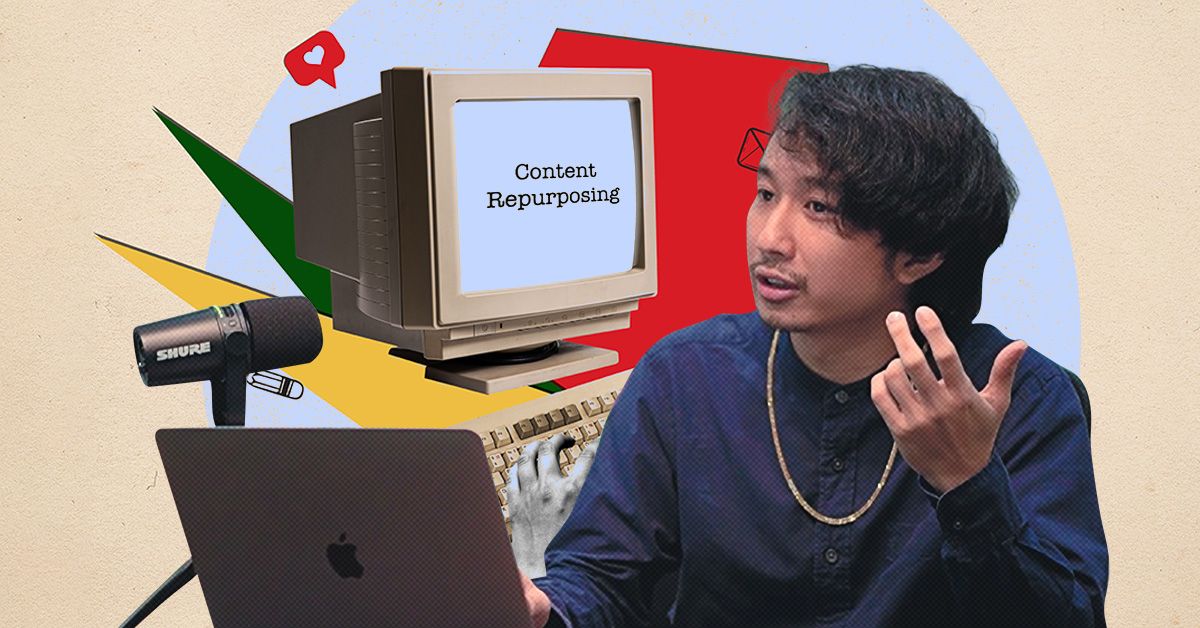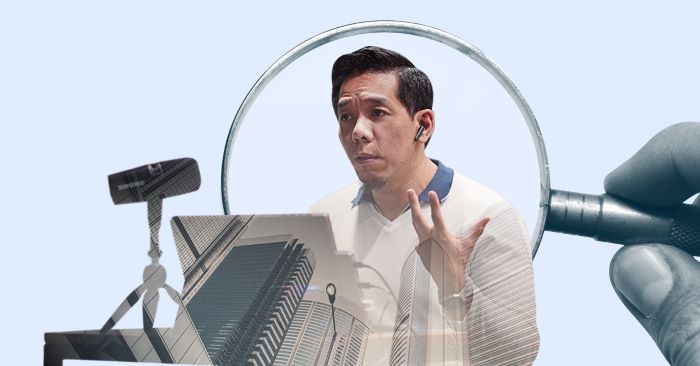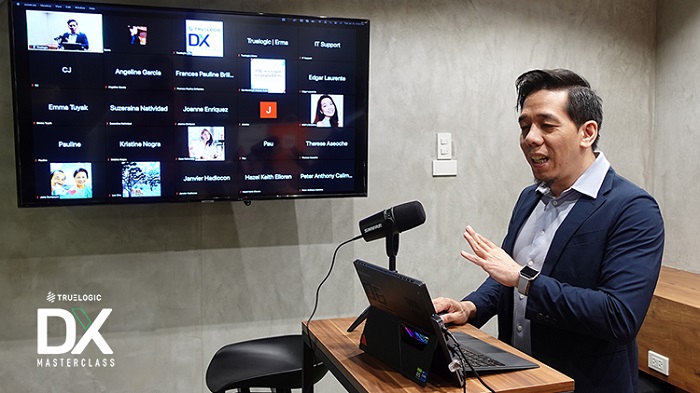Truelogic Episode 72 Recap: Content Repurposing as a Strategy: Performance Metrics to Check

Podcast Transcription
Pocholo Torres: Hello everyone, welcome back to the Truelogic DX Podcast, the ultimate destination for all things digital. I’m Pocholo, your resident senior marketing writer at Truelogic, and today we’re diving deep into a topic that’s been a game changer for content strategies, which is repurposing content and the necessary performance metrics to check.
As marketers aiming to craft impactful web content, we’re always looking to maximize our efforts. So, this is where content repurposing comes into play.
What is Content Repurposing?
At its core, content repurposing is defined as a strategic approach in which existing content is transformed and adapted into various formats, platforms, and contexts to extend its reach, relevance, and value. So instead of creating entirely new content from scratch, repurposing involves reimagining and reformatting existing materials such as blog posts, articles, videos, or podcasts into different mediums to target diverse audiences and meet specific goals.
So basically it can differ across different campaigns, and when you have different types of objectives as well, content repurposing can help serve these different objectives or purposes. For many digital marketing campaigns, content repurposing can be used to amplify your best-performing content and remedy ineffective content.
So if your in-house team or agency is not yet already doing this, today might be the most opportune time to start. So you might be wondering, how do we execute it effectively? When do we know it’s the right time to do content repurposing? What platforms are available for any given digital marketing strategy? What should we be looking at when we’re going to be repurposing content? And how do we know what type of repurposing format works best for a specific content type? So, we’ll be discussing everything you need to know to bring new life into your existing material and get more mileage out of it.
Understanding Content Repurposing
Did you know that a whopping 94% of marketers repurpose their content? At least 6% and we’ve already reached 100. So that being said, the overwhelming figure doesn’t necessarily always translate into campaign success.
According to a survey, 31% reported increased engagement, 21% mentioned heightened brand reach, and 15% experienced a boost in website traffic. For a successful content marketing campaign that utilizes repurposed content, these numbers can appear weak.
So let’s go over that again, right? 94% said that they repurposed their content. 31%, 21%, and 15% respectively discussed their benefits to their campaign. So if we assume that 21% said that it helped increase their brand reach, that also means that 79% did not agree
What these stats tell us is that we can all agree that it’s necessary at this point to repurpose our website’s digital content. But as a strategy overall, it also comes with its challenges and limitations. To reap its benefits, it has to be implemented accordingly. And it’s not just about saving resources like your writer’s bandwidth, time, and money, repurposing offers insights into what works and what doesn’t, which is the greatest takeaway that you can get from it as a strategy. It allows us to diversify our content. It also provides backlink opportunities and it even strengthens our brand messaging.
How Important is Content Repurposing in Digital Marketing?

So let’s say you’ve crafted an in-depth blog post that’s relevant to your brand products or services, and it resonates well with your audience. Let’s say it’s informative, engaging, and filled with valuable insights. Instead of letting it fade or stay obscured in your archives, why not transform that piece of content into an attractive eye-catching infographic? This visual format, when targeted at the right users on social media platforms, can help capture new readers who are more inclined to visual content.
Similarly, when you have a webinar that you’ve hosted, which is often only accessible for a limited time, that webinar episode can be repurposed into an on-page blog. This not only extends the lifespan of the original content but also caters to users who might have missed the webinar. This allows you to tap into a wider audience while also adding more relevancy to your website. So from a webinar into an on-page blog, there’s this sense of seamlessness when it comes to repurposing. So while you offer the webinar first and then later on release the blog, your content lives on your website which can help drive traffic or target incidental keywords, which is still relevant to your brand, business, or product or service.
Here’s one more scenario. Imagine turning a data-rich report, having statistics in there, numbers and figures, and then using it to make a checklist from a comprehensive guide. So these types of repurposed formats can help provide a quick, actionable piece of content for your audience. So it’s like getting the summary of the entire content, which helps improve engagement and provides them with a fresh perspective on existing content. So how do we effectively execute content repurposing for our digital marketing campaigns? This all starts with the key performance metrics. The key to knowing when to repurpose your content is hinged on having the necessary data. And these key performance metrics dictate whether or not repurposing content is the best move to make for your campaign. So as we mentioned some data earlier, the numbers aren’t overwhelming enough for us to conclude that content repurposing is an effective strategy for all your campaigns or all types of businesses.
Key Performance Metrics to Track for Content Repurposing
It’ll depend on your objectives, on your brand, products, or services, and also on what the data tells us. So having visibility over these quality and quantity metrics can enable us to also know which types of content we can leverage. So apart from user buying, email signups, and other performance indicators for success, here’s a list of other metrics that can prove relevant to your campaign
So you can either look at traffic and conversion metrics, SEO, and organic reach. You also have social media metrics, user behavior metrics, and also ROI or financial metrics. One other thing to remember is that these metrics will also vary according to your campaign’s objectives. For a certain brand, product, or service, you’re not limited to one campaign. You can have multiple campaigns, digital marketing campaigns, right? So that means having different objectives. So it’s all about aligning these metrics with your goals and ensuring that your agency or service provider is reporting meaningful data back to you. So what does that mean when we say meaningful data? It means that we have enough numbers to work with that allow us to either fix something that’s not working or amplify something that’s already working.
When tracking the metrics relevant to our objective, we’ll have to look at its impact on website SEO, how it figures into your social media campaign if you have any, and how it helps us understand user behavior. After all, when it comes to content, apart from knowing your brand or being familiar with its products or services, one important thing is always knowing who you’re writing for and why you’re writing for them. So for us to deliver true value always starts with knowing who you’re talking to first and providing relevant content in the process.
Traffic and Conversion Metrics
So when it comes to traffic and conversion metrics, we know that it is anchored on analyzing the traffic that we get to our website. So with repurposed content, analyzing website traffic and conversion metrics enables us to discover opportunities and insights into what drives users to either browse or buy and then vice versa, wherein these metrics also show us if our content falls short of a certain objective. If your repurposed content still fails to gain traffic or conversions, then there are strategies or services like conversion rate optimization or CRO to move the needle.
SEO and Organic Reach Metrics
SEO and organic reach metrics on the other hand are also relevant and related to traffic and conversion, right? The influence of repurposed content on SEO cannot be understated as it allows us as content marketers, writers, and copywriters basically to remedy website content that isn’t working.
So monitoring keyword rankings and organic search traffic through tools like SEMrush or HREFs can help us identify the pages and direct us toward the path that we want when it comes to making repurposed content work. This also emphasizes the role of backlinks and domain authority. So when discussing the impact of content repurposing on our website’s SEO, we can optimize old content through keyword insertions, adding more authoritative links, and using effective headings that communicate to search how relevant a certain topic is to our website or our niche.
Social Media Metrics
As we know social signals help establish a brand and their website. So benchmarking social media metrics such as reach, impressions, and follower growth enables us to discover areas for improvement when it comes to our content.
When you repurpose content from your website into social media posts, you’re reusing, I mean, reimagining your content for a whole different set of users. So for your website, you usually have users who are already interested or who have found you via search. For social media, depending on how you’re using yours, how you’re running your ads, or running you, managing your campaign, you can attract different types of audiences. So social media provides us with this opportunity to build brand awareness through repurposed content. So basically taking old content and reimagining it for social media users. Some examples can include your success stories, which can help generate more social media presence for our brands, or repurposing old content and adding it to our social media calendar. So instead of creating new content all the time, you can repurpose old content from your website or your ad, from your other channels.
User Behavior Metrics
User behavior metrics involve analyzing user behavior, like click-through rates, for example, scroll depth, and exit rates, Gaining audience insights from repurposed content allows us to discover if the content that we’re doing is aligned with how we expect our users to behave or take action.
So it informs us also of future strategies. So if we notice that our CPR has been increasing for three months, lets us know that maybe something isn’t working with the content. Let’s maybe change the CPA or add more relevancy to the content, creating a sense of seamlessness in the narrative that complements user experience.
ROI and Financial Metrics
Measuring the ROI from repurposed content campaigns can be done by basically calculating cost-effectiveness and revenue generated. This also allows us to explore long-term benefits for our team or agency, depending on how much work needs to be done or the capacity of your team on a monthly or yearly basis.
Repurposing content can take less time after your team gets used to it, as opposed to creating new content from scratch. A new blog post, for example, of anywhere between 700 to 1500 words can take around a couple of hours while repurposed content will warrant around half the time depending on how much work needs to be done. These are just baseline numbers that we can work with, but of course, with anything content, there are no hard rules. So there are just best practices that change over time. So as we wind down the discussion, here are some of the best practices and tools for content repurposing.
Best Practices for Content Repurposing
1. Start with high-performing content
You should begin your content repurposing journey by first identifying your top-performing content. These pieces have already proven their worth, making them excellent candidates for transformation. So by repackaging these content winners into different formats, you’re increasing their chances of resonating with even wider audiences.
2. Create evergreen content but leverage seasonal content
So as opposed to high-performing content, you have content that isn’t working. Through the use of tools that can check content quality or effectiveness, we can identify which pages on our website fall short of our objectives and discover if are they hitting any keywords or are driving traffic at all. If not, maybe we can repurpose them and make them more effective. How?
One way is leveraging evergreen content. So when selecting content to repurpose, you can also consider focusing on evergreen topics, which are topics that remain relevant over time. This ensures that your repurposed content continues to provide value long after its original publication date. On the other hand, you have seasonal content, which you can also repurpose year after year, basically to stay relevant to audiences who frequent your website or social media channels. So best SEO strategies in 2020 as an on-page blog can be repurposed to be the best SEO strategies in 2021 and 2022, and so forth.
3. Update and reshare old content

Don’t let your older content stay stagnant, especially if it’s not getting any traffic. As mentioned earlier, we can revisit and optimize our old content to reflect current trends and information, which we can then reshare across channels to reintroduce it to our audiences.
4. Cross-channel optimization vs. Omni-channel marketing
With that, we can also execute cross-channel optimization and omni-channel marketing. So when repurposing content, we have to think about how we tailor it for a specific channel. So, like for example, newsletter, content will require less number of words versus an on-page blog, which serves to drive more traffic by having substantial information. When doing cross-channel optimization or Omnichannel marketing, we are using different platforms.
It’s necessary to create a consistent experience for our users. Cross-channel optimization, for example, involves creating a seamless series of interactions across different channels to primarily enhance customer engagement and improve conversion rates. We can ensure that our message maintains its essence while adapting to different audiences. So for example, newsletter content will have less number of words but still contain the meat of the subject as opposed to an on-page blog, which can do a deep dive into all things important regarding a certain topic.
So creating a seamless experience for your users from email to your website, let’s say your newsletter, drafting the narrative through repurposed content makes it more effective and more natural for them. On the other hand, you have omni-channel marketing, which pertains to your brand’s visibility across different channels. Like, let’s say you have a website, a Facebook page, a Twitter account, or X account, basically encompassing all online platforms. You have to consider how all your marketing efforts should at least have an overarching narrative to make it more natural for your users seeking your brand or looking for products or services that you’ll offer.
5. Use Google Analytics and Search Console to identify the best-performing articles
Lastly, we have utilized tools for insights. So we can also take advantage of tools like Google Analytics or Search Console to gain insights into the performance of our content. These tools provide valuable data on audience behavior, sources of traffic, and more. So basically it helps us refine our repurposing strategy. Take for example how you can make use of different content formats from the same content, such as nurturing leads via EDM marketing, using an on-page blog and then turning it into a newsletter, turning it into a lead magnet, and then like a checklist of sorts. But basically, and then a social media post, right? So you can get more mileage out of your content by repurposing it and by using data and then repurposing it. So as you navigate the world of content repurposing, remember that flexibility and creativity are your allies. Don’t be afraid to experiment with various formats and platforms to find what resonates best with your audience.
Key Takeaway
When it comes to content marketing, there are no hard rules, but these best practices offer the best results so far. So as the online sphere changes and different brands adapt, and basically when everyone starts repurposing, what happens next? What can we do next? So we’ll have to adapt and exceed what’s already being done. And how can we do that? Through only flexibility and creativity. Using the data available to us, we can analyze, measure, and track what types of our content work and which of these content we can repurpose.
In wrapping up our content repurposing strategies, here are some of our key takeaways. So. repurposing boosts reach and value. It takes your existing material and magnifies its reach and value by adapting it to different formats and platforms. So, having the right metrics also drives success. Utilize performance metrics to measure the effectiveness of your repurposing efforts. Metrics provide us insights into what’s working and where you can improve, whether it’s in your content or your overall campaign. You can also tailor your content for success with repurposing. Having different content formats makes it suitable for the different platforms available. So, social media will truncate your post if the text in the caption is too long, for example. It also provides us with continuous learning. So we get to explore different ways to repurpose our content and stay updated with the different digital marketing trends.
Real-World Examples of Content Repurposing
So before we wrap up, I’d like to share some real-world examples of how we repurpose content here on Truelogic. So one example that we do quite often is creating infographics out of blog posts. We transform our informational blogs into eye-catching and engaging infographics to appeal to our audiences who are more keen, and keener on visual content. So we all know that scrolling mindlessly on our newsfeeds, we don’t want to read long texts. So infographics can help attract different audiences. We also have webinars and podcasts that we convert into blogs. We also offer checklists and guides that we use as lead magnets to nurture audiences via newsletters, which are sourced from traffic-driving articles that we create on our website. And also social media posts, we have carousel posts, standalone images, videos, and sound bites, which are sourced from our other materials.
And lastly, one other way to repurpose your content effectively is to leverage multilingual content. Being an agency here in the Philippines, we are aware that not all our audiences speak English, so sometimes we’ll have to code-switch, use a combination of Filipino and English, or sometimes also create blogs in Tagalog purely for some of our campaigns. These examples illustrate how content repurposing can take one piece of content and give it new life across different platforms.
Thank you for listening to another episode of the Truelogic DX Podcast. If you have any questions, comments, or suggestions, feel free to give us a shout-out on social media. Truelogic DX is available on Spotify, Google, and Apple accounts. Check our website for more digital marketing resources. Don’t forget to subscribe to the Truelogic DX Podcast and set up your alert for new episodes. The Truelogic DX Podcast is powered by Podmachine.










